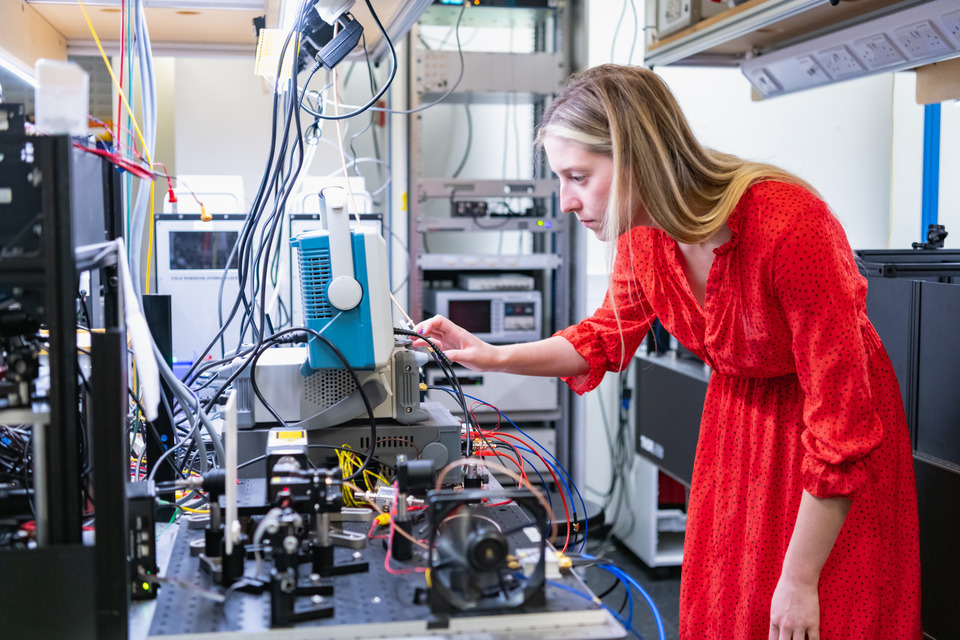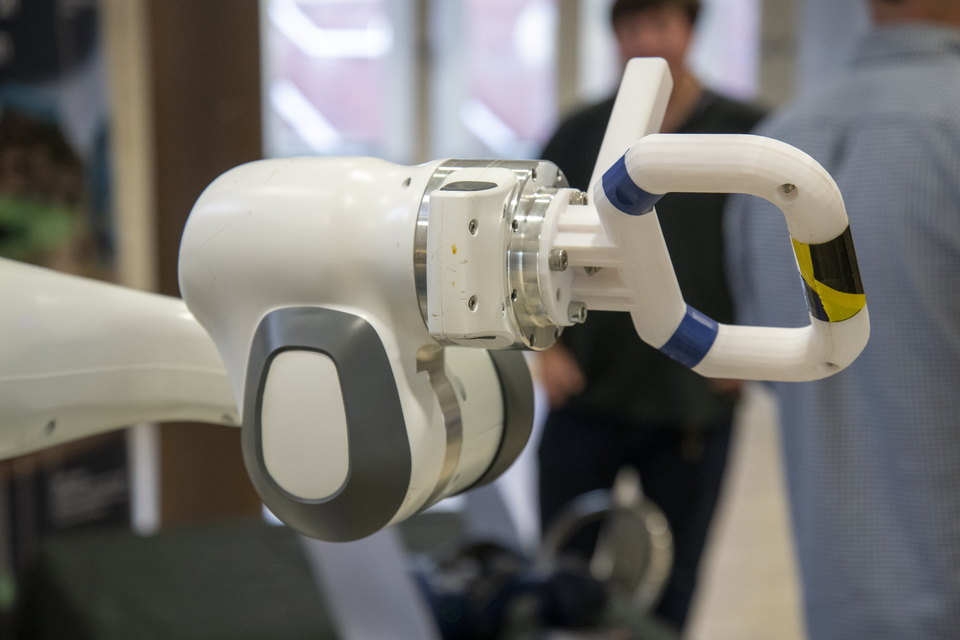Science and Technology Collaboration and Engagement Strategy – Accessing More UK Talent
Published 13 February 2023

Scientist with satellites
Take part in our supplier survey.
1. Foreword from MOD Chief Scientific Adviser
In the Ministry of Defence’s (MOD) Science and Technology Strategy 2020, I spoke of the uncertain and turbulent times we live in, and how Defence science and technology must lay the foundation for the generation-after-next of military capability to ensure the UK maintains its strategic advantage. Subsequent events, most notably Russia’s invasion of Ukraine, have thrown into sharp focus the necessity of this endeavour.
But achieving this objective is not something MOD can do alone. The Defence Security and Industrial Strategy (DSIS) notes the importance of working with academia and industry on early-stage science and technology through to demonstration, testing and delivery of military capabilities. Our domestic industrial and research sectors provide a rich resource with which to do that, with the UK ranked 4th in the Global Innovation Index 2022.
This Collaboration and Engagement Strategy outlines the steps Defence will take to build on the excellent relationships we have with small and medium-sized enterprises (SME) and academia, recognising their contributions are as important as the ‘primes’ are to Defence.
By positioning MOD as the partner of choice for SMEs and academia working on defence-relevant science and technology; by designing-in collaboration to our policies, processes, and systems; and by clearly communicating our needs, including the priority challenges we are seeking to address, we will ensure our partnerships are ready to meet the challenges of the 21st Century.
Professor Dame Angela McLean DBE FRS

MOD Chief Scientific Adviser Dame Angela McLean
1.1 Context
Over the last half century, the centre of gravity for scientific and technological progress in the UK has moved away from government laboratories and research facilities to a wide range of organisations, from individual researchers through to large defence contractors, known as ‘primes’. MOD must adapt to this continually evolving dynamic if it is to maintain its strategic advantage in an increasingly competitive world.
As stated in MOD’s Science and Technology Strategy and the Defence and Security Industrial Strategy (DSIS), successfully leveraging the capability of UK industry and academia is key to maximising the defence and security opportunities inherent in emerging and disruptive science and technology, and the generation-after-next capabilities they can lead to. At the same time, an ever more globalised economy has led to increased competition for this resource – both from private organisations and other nation states.
So far, MOD has been slow to adapt, and we are not making use of the full extent of talent in the UK. Worse, our competitors are making use of it ahead of us. Feedback from relevant communities suggested our current approach to collaboration and engagement benefitted large defence contractors, known as ‘primes’, but did not consider small and medium-sized enterprises (SME) and academia.
This strategy outlines the organisational and behavioural changes Defence will make in its overall approach to collaborating and engaging with SMEs and academia to enhance our relationships.
2. Strategy vision and scope
To fully capitalise on the capability available within UK industry and academia, MOD’s vision is to become the partner of choice for academia and industry engaged in defence-relevant science and technology. Specifically:
-
‘Partner of choice’ means the best UK-based talent and capability prefers to work with us – and find it benefits them to collaborate.
-
‘Defence-relevant science and technology’ will most likely require targeting individual researchers, academic institutes, other funders of research, spinouts and SMEs.
This strategy does not cover the whole of Defence’s relationship with the entirety of UK industry. Our relationship with larger businesses and primes sits outside of this strategy as we already have substantial and mature relationships with those partners. MOD is often already their customer of choice due to our size and scale. Mechanisms to engage with larger UK defence suppliers already exist and are detailed in the DSIS, our commercial frameworks and other advisory documents.
The Defence Suppliers Forum (DSF) is a great way for industry colleagues to discuss directly with MOD. While we will always work closely with the primes, this strategy is a recognition that MOD needs to actively cultivate its wider supplier base.
3. The way in which we will become the partner of choice
To become the partner of choice, we will do the following things:
• Communicate and engage with external partners in the way they want and need to be communicated with. We will be more flexible with how we engage with academia and SMEs, tailoring our approach to their unique characteristics and requirements wherever possible.
• Make it as easy as possible for external partners to work with us. Whilst maintaining essential principles such as the security and integrity of contracted research, we will ensure MOD policies and processes promote, rather than inhibit, ease of working.
• Aim to provide the best offer available. We will aim to make our offer the most attractive out of a crowded field. This means adopting an attractive approach that goes beyond just financial considerations.
• Create positive MOD-industry-academia relationships. We will use MOD’s considerable internal investment in science and technology to positively shape the UK industrial/research sector, supporting them consistently throughout, thereby creating a more mutually beneficial innovation ecosystem.
For example, we can create strong demand for innovative products and services or be more willing to externally make use of our own science and technology and Intellectual Property (IP) to both benefit from, and build up, the capability of the private sector.
3.1 Case study: Aiming to provide the best offer

A miniature drone linked up to a mobile phone
UK aerospace company Flare Bright is pushing the boundaries of embedded AI technology to develop autonomous drones which will help frontline troops gain much needed situational awareness in even the most difficult conditions.
With the help of DASA funding, they have developed SnapShot – a ruggedized nanodrone, designed to be the simplest way to obtain aerial images at the touch of a button and send them straight to a smart phone or tablet.
DASA funding has helped Flare Bright develop their technology from prototype to a market-ready demonstration product and the company is now keen to showcase SnapShot’s unique benefits to future users in the defence and security community. They also plan to work with stakeholders to further develop SnapShot’s capabilities.
Chris Daniels, Chief Commercial Officer at Flare Bright said:
DASA funding has supported our credibility in the defence and security market and demonstrates confidence in our technology. It really has been a key foundation of our company’s success.
Over the last five years, Flare Bright has gone from strength to strength. Winning new investments and contracts has enabled them to quadruple their headcount and move to larger premises. In 2021 they were awarded an Octopus Award for Entrepreneurship, to celebrate their growth during the COVID-19 pandemic. They have also secured additional funding through Innovate UK’s Future Flight Challenge, a programme which aims to develop greener ways to fly by advancing electric and autonomous flight technologies.
4. The capabilities we must have to enable us to do those things
MOD will ensure we have the following capabilities to enable us to become the partner of choice:
• An agile commissioning and contracting mechanism. Academics, academic spinouts and SME value agility, early adoption and a risk-tolerant approach. To be partner of choice, MOD needs a commissioning and contracting mechanism that meets those principles.
• An accurate understanding of what we want, and an ability to articulate that externally. MOD needs to be able to simplify the narrative of what it wants and when, and then broadcast its needs externally in an easily understandable and accessible way for others to act on. ‘What we want’ also includes our expectations on external partners when they work with us, such as on the security of their research.
• An understanding of how academia and SMEs want and need to be communicated with. Defence needs to tailor its engagement plan to get the most from individual sectors. Collecting feedback from partners to understand the drivers for collaboration within academia and industry, as well as how to communicate better, will help customise messaging.
4.1 Case study: Strong relationships with trusted partners

Scientist in quantum laboratory
Cold atom gravity sensing technology was identified as a promising technology with future applications for defence and the potential to support economic growth. The National Quantum Technology Programme (NQTP) was formulated in 2014 and both MOD and the Defence Science and Technology Laboratory (Dstl) significantly shaped the design and intent of the programme.
The national programme set in motion several projects that would be beneficial for Defence and prosperity, including the Sensing and Timing NQTP Hub leading on the development of cold atom systems. In parallel, Dstl funded a multi-million pound multi-year gravity gradiometer project, with the Hub and industrial partner Teledyne-e2v, to develop a demonstrator for detecting underground tunnels and infrastructure.
Building on this, in 2018, after small scale commercial, feasible and development projects, Innovate UK followed Dstl’s investment with Pioneer, a large scale project to commercialise the technology. Developments are still occurring in this area as this year, the world’s first demonstration to find tunnels buried outdoors in real-world conditions one metre below the surface was performed.
A Nature article entitled Quantum Sensing for Gravity Cartography describing the experiment was published, showing the teamwork and contributions from academia, industry, and government required to make this happen. And it doesn’t stop there, through the NQTP, work continues across government to help spin-out companies mature this technology to reach the strategic goals set in 2014, and updated in 2020, for quantum technologies.
• The ability to learn from what other countries or competitors are doing. Defence can learn from allies and partners. For example, what science and technology they are investing in, and why they are pursuing a different approach or technology; or how they engage with their academic and industry partners. We can then adapt our own approach, thereby giving us a competitive edge.
• The ability to create resilient and long-lasting relationships with stakeholders. This means moving beyond the primarily transactional relationship that typifies MOD’s engagement with private organisations and being able to tap into and support the diverse mix of motivations present in industry/academia. Such motivations can include: financial; academic credential; publication opportunities; career progression and opportunities; job security; or the thrill of discovery.
• Funding. Fundamentally, to do any of this MOD science and technology needs to be able to access the relevant funding and distribute it at the pace and in the way required by academia and SMEs.
5. Implementation
To achieve the above, in the first instance MOD will implement the following systems changes:
-
Collect information on how to engage with academia and SMEs. Feedback will be continuously collected direct from stakeholders on how best to engage. This will ensure the mechanisms evolve and stay relevant to those they are meant for, not just those that have the capacity and resource to understand and use them.
-
Create capacity to build stronger relationships with our trusted partners. These could be regional or based on a specific capability. They will enable us to build close working relationships with academics and ensure that good ideas are picked up.
-
Improve existing commercial mechanisms and procurement systems, and look to develop more flexible arrangements for working with Defence. While all applicable mechanisms and systems will remain available for use, in the short term we will prioritise those existing ones that we believe are best for academia and SMEs. Longer term, we will look to invest in developing more agile and accessible tools which suit the needs of these partners.
-
Implement an internal mechanism within science and technology to coordinate our needs and requirements. This will foster greater cooperation between MOD Head Office, the armed forces, and delivery agencies by challenging our internal system to get better at understanding (and communicating to our supplier base) what it wants. It will help link different but related needs and requirements set out in publications such as the Defence Technology Framework (DTF), Areas of Research Interest (ARIs) and Science and Technology Strategy 2020, among other products.
-
Create a single science and technology portal. This will provide a front door into the world of MOD science, technology and innovation, making it easier for external partners with good ideas to access the right part of the system. It will also act as a one stop shop for everything they need to work with Defence and understand what we want from them: Collaboration opportunities, commercial frameworks, recent publications, requirements, etc.
-
Instil an agile, risk tolerant culture among decision makers. The agile contracting mechanisms will only work if they are managed by decision makers who are also able to think in an agile way – whilst taking a balanced view on risk. That also means being open to challenge from external partners.
-
Adopt more effective stakeholder/customer relationship management systems. This will reduce the resource burden and lead to more fruitful partnerships in the future. For example, by using stakeholder/customer relationship management tools.
-
Update our security infrastructure environment. We will create a system to enable easier working with external partners at SECRET and above. We have the systems in place to do this with primes, large companies and the bigger universities, but not with the individual researchers or SMEs. We will need to update the operating system and fixed infrastructure (e.g. facilities) elements of our wider security infrastructure.
-
Foster skills mobility. Seconding external researchers into MOD/Dstl or placing MOD/Dstl researchers into industry/academia enables a greater exchange of skills between UK academia, industry and Defence, the ability to work on shared challenges, and overall uplift in UK capability. We will look at both long- and short-term placements.
-
Be more flexible and strategic with how we fund academics to maintain the skills supply chain. This can mean the long-term funding of people, rather than positions, or offering recruitment routes for post-doctoral students with transferrable skills.
-
Involve external partners in more MOD business. Academia/SMEs have a wide skill set beyond just research development contracts or science and technology acquisition. We will involve them holistically in more of MOD’s science and technology business, such as through red teaming, acting as a challenge function for key science and technology products like the Problem Book (which helps guides the development of MOD’s science and technology portfolio), or working together with MOD scientists in co-creation centres.
-
Actively learn from international partners. We will develop internal research and advice on the defence-industrial and -academic relationship of key international partners.
5.1 Case study: Making it easy to work with us

robotic arm
Procured and managed by Dstl, RCloud is a Supplier/Buyer Marketplace (sometimes referred to as a Dynamic Procurement System or DPS), providing “low barrier to entry” opportunities for SMEs and Academia to sell to and work with Dstl, UK MOD and wider UK Government.
It is designed for use in contracting Science and Technology Research and Development up to Technology Readiness Level (TRL) 6 (Technology demonstrated in relevant environment).
Currently over 70% of RCloud suppliers are SMEs.
Key Features of R-Cloud – What makes it unique?
- Direct Contracting - Opportunities to contract directly with Dstl / MOD
- Dynamic Agreement - Join at any time during the R-Cloud term Simple Application - Entry via a single application managed in the online Portal
- Target Key Areas of Interest - Engagement can be targeted to the most relevant areas of capability or interest
- Relevant opportunities pushed to you - Rather than having to search for them
- Efficient Process via the Online Portal - Standardised terms and conditions and tasking documents
- Intellectual Property Ownership - IP ownership remains with the supplier
For further information and to register: https://rcloud.dstl.gov.uk/
Any questions or help please email: dstlrcloud@dstl.gov.uk
6. Next Steps
MOD already hosts webinars and workshops, alongside conducting, publishing and responding to surveys on collaborating with partners, such as the Selling to and Working with Dstl survey and Doing Business with Defence webinars.
To show our commitment to this strategy, we will collect information by taking a snapshot of this data after the release of this strategy. We will use this information to inform the improvements we will make to collaboration and engagement within MOD.
Take part in our supplier survey.
We will use future engagement events as well as existing forums to update on our progress on implementing changes against this strategy as time progresses.
Please contact us through DST-Secretariat@mod.gov.uk if you would like to provide more specific feedback or would like more information.
6.1 Useful links
- Defence Science and Technology (DST)
- How to work with or sell to Dstl
- Defence science and technology programmes and projects
- Dstl Searchlight webinars - engaging SMEs, academia and non-traditional defence suppliers.
- Defence and Security Accelerator (DASA)
- MOD Procurement
- MOD acquisition pipeline
